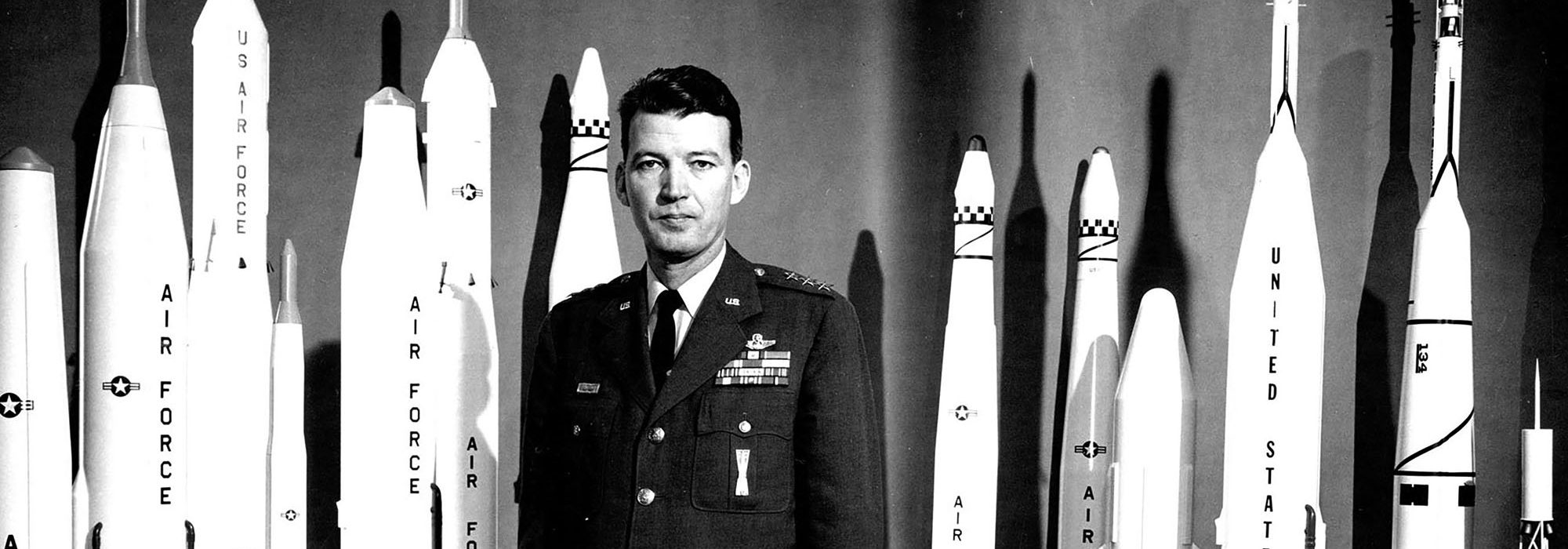The Bomber Pilot Who Rocketed the Air Force into Space.
Bernard Schriever is considered the father of the U.S. space and missile program. He was born in Bremen, Germany, in 1910 but immigrated to Texas with his mother in 1917. He attended Texas A&M and then joined the Army and became a pilot. His first operational tour was in 1933 at March Field, Calif., flying bombers: his commander was Henry H. “Hap” Arnold, the deputy was Carl A. “Tooey” Spaatz, and another pilot on the field was Ira C. Eaker—an impressive crew.
He was only a reserve officer, so seeing no future in the Air Corps, he left in 1937 to fly for the airlines. One year later, however, Arnold coaxed him back into the service with a regular commission. After a tour in the Engineering Division as a test pilot at Wright Field, Ohio, Schriever earned a master’s degree in aeronautical engineering at Stanford University. Upon graduation he returned to the cockpit and became a B-17 pilot in the Southwest Pacific, flying 33 combat missions. His abilities as an engineer were, however, increasingly obvious, so Gen. George C. Kenney of the Far East Air Forces made him one of his chief maintenance officers.
He returned to the Pentagon in late 1945 and “Hap” Arnold once again took a hand, making Schriever head of the Scientific Liaison Branch. For the rest of his career, he remained in the engineering sector, but stayed involved in research and development. To Schriever, this was the future, and he would have a major impact on what aircraft and systems would be developed and procured. This often brought him into conflict with operational commanders who had their own thoughts on such matters. He had serious problems with Gen. Curtis E. LeMay at Strategic Air Command, and these conflicts were over things such as the best air refueling method, whether bombers should penetrate at high altitude or low, and indeed, which bombers should be bought at all. LeMay resented the forceful pushback from the young colonel, but Schriever held his ground and won as many arguments as he lost. His intellect, calmness, and logical approach made him very persuasive.
One of the biggest areas of disagreement concerned ballistic missiles. Schriever believed in them; LeMay preferred manned bombers. Schriever had the backing of the Air Staff and would ultimately prevail in this battle. In addition, the thermonuclear breakthrough in the early 1950s meant that warheads could be built that were far more powerful but also a fraction of the size of early atomic devices. Later, LeMay would grudgingly admit that Schriever had been right.
Interestingly, Schriever had no experience with missiles or rockets up to that time. Yet, he was highly intelligent, a quick learner, and was a visionary. He saw the future and realized how important these mechanisms would soon become.
As commander of the Western Development Division as a brigadier general, he was put in charge of the missile program. Schriever was responsible not only for pushing the concept of missiles and rockets, but also ensuring they were built. Timing was important. The Soviets were known to be developing nuclear-tipped ballistic missiles as well, so the race to get there first was a top national priority.
The first Atlas long-range missile squadron was activated in April 1958, and the first Thor intermediate missile unit was stood up four months later. The Minuteman, another Schriever project, would be set in silos four years later. If there ever was a missile gap, it quickly closed.
Because these missiles were designed to carry nuclear weapons intercontinentally, it was obvious that accurate targeting would be necessary. This required spy satellites. Schriever took charge of those programs as well, which quickly expanded to include communications, weather, and launch warning satellites. He was responsible for missiles and space.
In July 1961 Schriever was promoted to full general and made commander of Air Force Systems Command (AFSC). This huge organization, headquartered at Andrews Air Force Base in Maryland, was responsible for all development, research, and acquisition of Air Force systems. By 1963, AFSC was employing 27,000 military and 37,000 civilian personnel, and Schriever was responsible for 40 percent of the Air Force budget.
Bernard Schriever was an effective organizer and manager, but also an adept leader who inspired loyalty among his subordinates. He had rules about leadership: never set a rule that was enforceable; always get the staff on your side first; and always show that you care—about your people and their tasks. It was commonsensical and sound advice that obviously worked.
Schriever retired in 1966 and became an elder statesman within the air and space community for the next 40 years. There are two good biographical studies on Schriever: a book chapter by Karl Mueller in John Andreas Olsen, “Airpower Pioneers” (Naval Institute, 2023), and a full biography by Neil Sheehan, “A Fiery Peace in a Cold War: Bernard Schriever and the Ultimate Weapon” (Random House, 2009).

